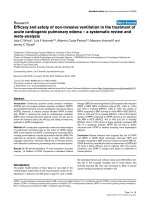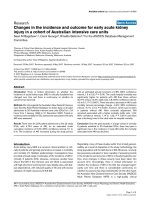Prevention and treatment of acute kidney injury in the ICU
Bạn đang xem bản rút gọn của tài liệu. Xem và tải ngay bản đầy đủ của tài liệu tại đây (1.95 MB, 33 trang )
Dr. Farmer
Prevention and
Treatment of Acute
Kidney Injury in the
ICU
Prevention and Treatment of Acute Kidney
Injury in the ICU
J. Christopher Farmer
Learning Objectives
To discuss…
–
–
–
–
Pathophysiology, risk factors, and etiologies of
AKI
Current and emerging methods of early diagnosis
Prevention of AKI
Treatment of AKI
Epidemiology and Pathophysiology
Increasing Incidence of AKI
Nash, et al: Am J Kidney Dis; 2002, 39:390
Arterial Vasodilatation and Renal
Vasoconstriction in Patients with Sepsis
Diagnosis and Classification of AKI
Diagnostic Criteria for AKI
An abrupt (within 48 hours) reduction in kidney function currently defined as:
1.An
absolute increase in serum creatinine of more than
or equal to 0.3 mg/dl, or
2.A percentage increase in serum creatinine of more
than or equal to 50% (1.5 fold from baseline), or
3.A reduction in urine output (documented oliguria of
less than 0.5 ml/kg per hour for more than 6 hours)
Mehta et al: Critical Care; 2007, 11:R31-R39
“RIFLE” Criteria for AKI
Bellomo & the ADQI workgroup: Critical Care; 2004, 8:R204-R212
Classification of AKI Severity
Mehta et al: Critical Care; 2007, 11:R31-R39
Mortality Associated with Rising Serum
Creatinine
Unadjusted
Adjusted for age & sex
Multivariable analyses
Chertow, et al: J Am Soc Nephrol; 2005, 16:3365-3370
FENa = (UNa/PNa) / (UCr/PCr) X 100
Calculating the FENa is useful in AKI only in the presence of oliguria
In patients with prerenal azotemia, the FENa is usually less than 1%
In ATN, the FENa is greater than 1%.
Exceptions to this rule are ATN caused by radiocontrast nephropathy,
severe burns, acute glomerulonephritis, and rhabdomyolysis
In the presence of liver disease, FENa can be less than 1% in the
presence of ATN
Because administration of diuretics may cause the FENa to be greater
than 1%, these findings cannot be used as the sole indicators in AKI
FEUrea = (Uurea/Purea) / (UCr/PCr) X 100
Fractional excretion of urea (FEUrea) can be
obtained since urea transport is not affected by
diuretics
FEUrea of less than 35% is suggestive of a prerenal
state
Early Detection of AKI is Difficult
Jo, et al: Clin J Am Soc Nephrol; 2007, 2:356-365
“Earlier” Detection of AKI
Induction of NGAL protein after unilateral or
bilateral ischemia
Mishra, et al: J Am Soc Nephrol; 2003, 14:2534-2543
Urinary IL-18 as an Early Marker of AKI
IL-18 as a marker for the
diagnosis of ATN and
delayed graft function:
•ROC - discriminatory power
of IL-18 for the diagnosis of
ATN
•The area under the ROC
curve was 0.95
Parikh et al: AJKD; 2004, 43:405-14
Future “Cardiac Biomarkers” of AKI?
Parikh et al: KI; 2006, 70:199 -203
Coming soon?
Biomarker
Sample Source
Assay
Commercial Development
NGAL
plasma
Western blot
In development (Biosite)
NGAL
urine
Western blot
In development (Abbott)
IL-18
urine
ELISA
NONE
KIM-1
urine
ELISA
NONE
Cystatin-C
plasma
Immunonephelometry
In development (DadeBehring)
Prevention of AKI
Prevention of AKI
➼
?
X
Venkataraman, et al: Crit Care
Med; 2008, 36:S166-S171
Maintaining Renal Perfusion Pressure
No absolute number is considered adequate with regard to mean
arterial pressure, and target mean arterial pressure should be
individualized based on the patient's baseline physiology
Vasopressors should be used to improve perfusion pressure only after
adequate volume repletion is accomplished
No reliable evidence that norepinephrine is associated with increased
risk of AKI when used to treat arterial hypotension
Intra-abdominal hypertension is associated decreased renal perfusion
and may result in AKI
Prompt recognition, monitoring, and early surgical treatment offer the
best potential for recovery
Role of Loop Diuretics in AKI
maintaining a greater urine flow to flush out the tubules with loop
diuretics has been advocated to prevent AKI
Two meta-analyses have pooled studies evaluating the role of loop
diuretics in the prevention of AKI
–
–
The first systematic review compared fluids alone with diuretics in people
at risk for AKI from various causes and found no benefit from diuretics with
regard to its incidence, need for dialysis, or mortality
In the second recent meta-analysis (RCTs, n = 849 patients), no difference
among patients treated with loop diuretics was found in hospital mortality,
need for renal replacement therapy, or number of dialysis sessions needed
Treatment of AKI









